Hu of, Herr Schmeisser? (continued)
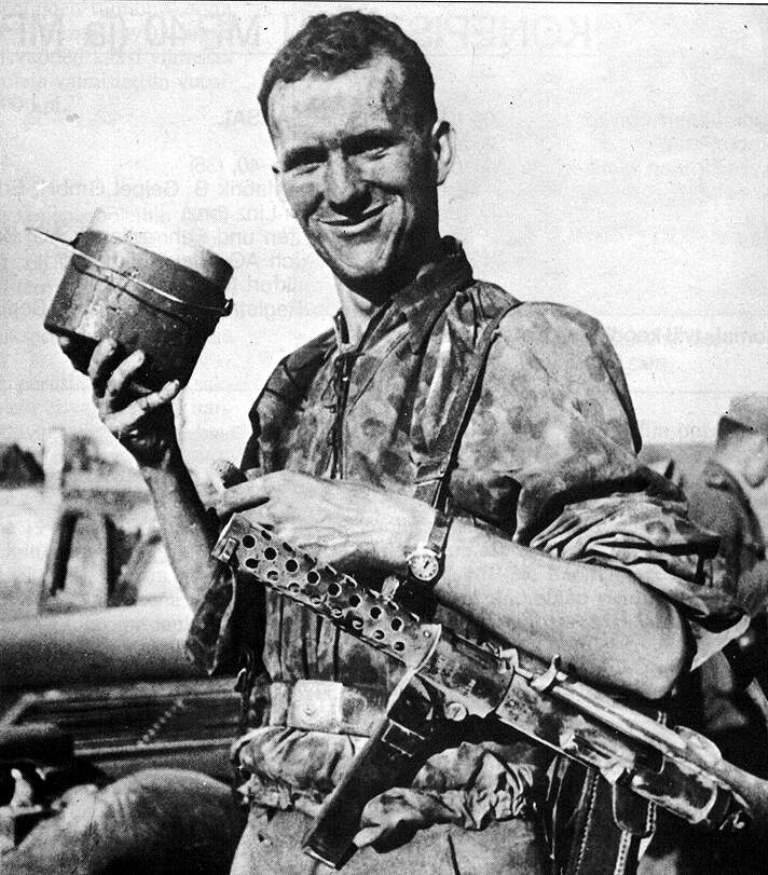
Part Four How the Schmeisser brothers held a raider seizure of Herr Hänel’s firm
World War I ended. In the distant Altai region, in the family of the Russian peasant Timofey Alexandrovich Kalashnikov, the 17 child was born, who was named Misha, and a huge copper basin fell on the German military industry. Having lost military contracts, Vollmer deals with everything that at least somehow can bring income. He is engaged in machines for the release of chains, milling machines, locks, spark plugs and even motor-plow. In 1923, he creates a machine for sharpening saws, which he called the “sharpening machine”. In a word, he spun as he could, raised his business, earning and letting others earn money. And it works not only as a designer, but also as an organizer of production. And so it was until 1929, the year of the Great Depression, which put hundreds of thousands of enterprises around the world on the verge of bankruptcy.
And what was Schmeisser doing at this time? Under the terms of the Versailles Treaty, the Bergman firm was allowed to issue only police weapon. And then in perspective. Under these conditions, the head of the company negotiates the licensed production of MP-18 with the Swiss company SIG. And here it seems that the absolutely inexplicable act of Schmeisser appears. He suddenly declares that since two of his patents are used in MP-18, Bergman does not have the right to negotiate with a third-party firm without his consent. In place of Bergman, I would
Schmeisser agrees with the Belgian company Pieper on the licensed production of MP-18 and begins its own independent path. But people familiar with the case, the question immediately arises. It is impossible to simply sell or get the right to manufacture. For the production of the necessary documentation, which according to the law is at the company Bergman and is his property. Dimensions of parts, calculations of tolerances, machining modes, steel grades. Without a technical education, Schmeisser could not completely reproduce from memory all the design and technological documentation for a weapon in order to start its production in Belgium. Who said "stole"?
There is nothing strange in the fact that the designer wants to create a company with his own name. But the firm with the Schmeisser trademark did not appear at first. Although the firm was established "Industriewerk Auhammer Koch & Co" (Auhammer Koch). Actually Koch in this company was a manufacturer, that is, a person responsible for the business, business. Well, Co is of course two brothers - the designer Hugo and the merchant Hans. As we have already said, nothing but a weapon from Schmeisser's head came out even on an empty stomach. In 1920, he patented a 6,35mm vest pistol (also using his father's prototype). It would seem that a manufacturer, a designer, and a merchant is an ideal set of roles. Take loans, buy equipment, hire workers, manufacture products, sell, repay loans. But it didn't work out. Volmer succeeded, but Schmeissers did not. The brothers clearly lacked the ability to organize their own production of these pistols. And then Gerberg Hanel appears on the stage.
A few words about Herr Hanele and his company founded in 1840. The company was also an armory and suffered from the Versailles Treaty along with everyone else. The grandson of the founder Gerberg Hänel was younger than Hugo Schmeisser by 7 years. In addition to the softness of character, apparently, differed by the lack of technical vein. By the time in question, Hänel’s company was left without its chief designer and technical director, therefore the interests of the parties coincided with 11 in March 1921, the contract was concluded. Under this agreement, Handel received the exclusive right to manufacture Schmeisser pocket pistols, but he did not have the right to manufacture weapons of other brands. Hm
Pocket handguns did not help out Henele's company. Production of other products - bicycles, hunting and pneumatic guns did not find demand and was worse than competitors. The company was confidently going bankrupt. And in 1925, the Schmeisser brothers carried out a typical raider seizure of Herr Hänel’s firm. This is how it happened.
As already mentioned, there was no technical director at Hänel. In our opinion, this is the chief engineer of the enterprise. Hugo Schmeisser, who has the experience of a technical director at Bergman’s firm, was suitable for this role as Lee Iacoccus for Chrysler, that is, perfect. But unlike the American manager, who set himself a salary of one dollar, while Chrysler was on the verge of bankruptcy, Schmeisser did not hesitate. Hugo took the place of technical director, Hans sat in a commercial chair. They set their salaries on par with Herr Hanel on 900 gold marks. In addition, the brothers received:
- royalties for patents
- 1 / 6 share in the capital of the company Hänel (each) and, accordingly, the share of profits after the payment of fees for patents
- the obligation to support financially the very same Schmeisser firm "Industriewerk Auhammer Koch & Co",
- and most importantly, Schmeisser got general power of attorney to perform all actions on behalf of the company without having any rights to this company and not answering anything for it! Even with their patents, which were registered at the new company for the production of cars (!) "Schmeisser Brothers". Why not on "Auhammer Koch"? Because she was already brought by glorious brothers to bankruptcy.
I am far from the idea that Herr Henele was tortured with an iron or a soldering iron. They say his sisters with tears in their eyes detracted to disagree with Schmeisser under such conditions ... Well, how? “... and most importantly without much remorse».
And at this time. Louis Stange and several other designers transferred the rights to their patents to Raintmetall. And did not regret. The bar, for example, bought three houses for interest. And more land. Under the tomatoes.
Well, what did Herr Handel get? ABOUT! He received something more than the right to Schmeisser patents. He got hope. The hope that sooner or later the former technical director of Bergman will invent something that will find demand and will not allow his company to disappear completely.
Part Five How Schmeisser was starting to become famous
Technical note on Schmeisser's vest gun.
In 1905-1906, the father of all automatic pistols and weapon automation systems, John Moses Browning, developed the form factor for the small-sized pocket pistols in the face of the M1906 model:
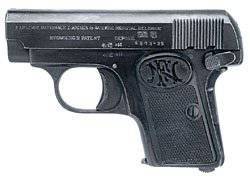
Since then, only the lazy one has not copied this form factor and has not tried to contribute to this small device. The locations of the springs, the fuses, the sight device, the disassembly order — with and without a screwdriver — changed. For all these variations, tons of patents have been obtained in different countries of the world.
Not passed this cup and the father and son Schmeisser. Dad changed the design, patented (as usual) and issued the model Dreize M1908. At the same time, natural modesty did not allow him to write on the fence "Patent Schmeisser", although he had every right and a patent in his name:

The sons did not become shy. They managed to make changes to this small space for as many as four German patents, which they did not hesitate to notify users of the corresponding caption:
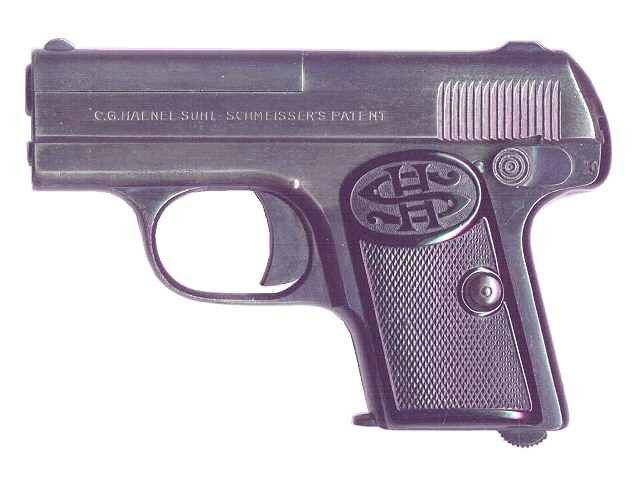
This is a normal evolutionary process, when the designer, using the model of another designer as a prototype, makes its own changes. In the end, only the consumer can give an assessment of the solutions that he embodied in the metal. Sometimes it brings great results, as was the case with the Borchard-Luger pistol. But sometimes, when the design is already perfected, it turns into attempts to entertain the “vanity” own vanity by putting its name on the product, which already has a certain fame and success without them. This is about the same as what is happening now with AK-12, Pecheneg, BC-121. But the brothers had another goal. Like this modestly the word Schmeisser began to enter the mass consciousness of consumers. In fact, you come to the store and say:
- Geben zi world bitte automatic-pistol caliber seks coma funf und vyressih varentsayhennen Hanel. Their möhte di katze mine mother-in-law Erschissen ...
Long and tedious. Whether business:
- Zi haben "mayser"? Their shyhssen mehte ... Danke shyon!
Pay attention to the consonance "Schmeisser", "Schissen (shoot)", "Schön (fine, good, beautiful)." Briefly and clearly what they mean. Learn marketers:
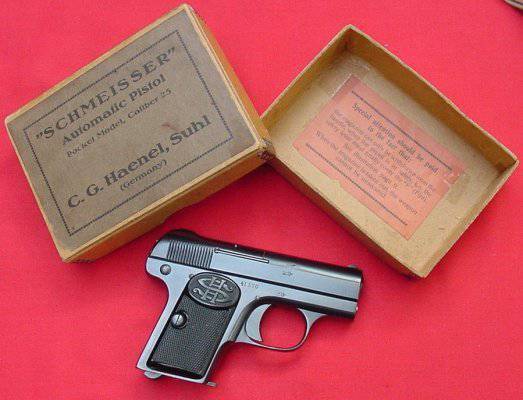
Not a zakos under the product has already received the name "pocket browning" in civilian everyday life.
Perhaps in this approach there is a rational grain, somewhere on the verge of morality. But for such a trick Handel had every right to call in Schmeisser with a candelabra:
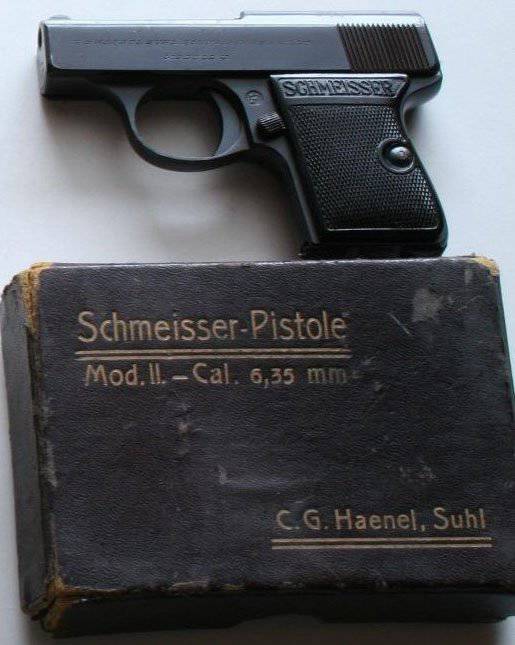
According to the unwritten rules of etiquette, on the top of the lining of the handle was placed the emblem of the brand of the enterprise that produced the gun. Even Browning did not encroach on the sacred and on his model in this place was the trademark of the Belgian FN. The inscription SCHMEISSER on the handle did not speak about anything, There was no such trademark. But on the other side:
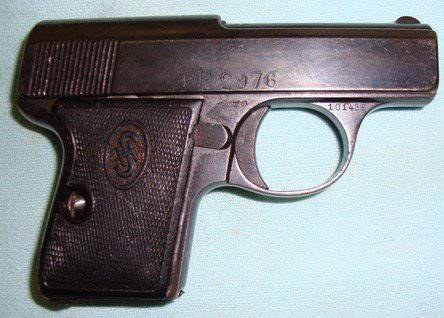
A more modern HS Wesel appeared, which in the sub-album already begins to resonate not with HAENEL SUHL, but with Hugo Schmeisser. Yes, like this, very modestly.
Technical information about the shop to Parabellum with Schmeisser patent. I give this information in order to facilitate the work of the curious, who, after reading the article, will begin to google according to the key “patent schmeisser”. To their surprise, they stumble upon this:
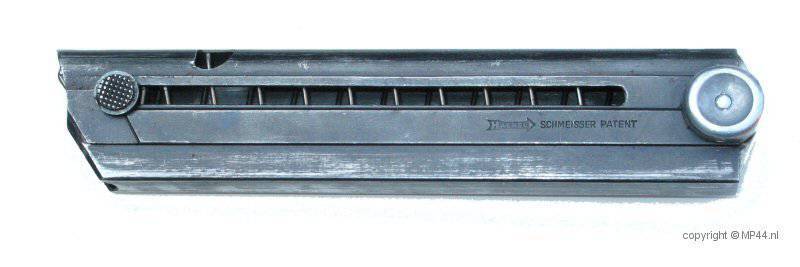
At the end of the 1930s, the inscription "SCHMEISSER PATENT" appeared on the shops of the Parabellum police officers. But what does Schmeisser and Handel have to do with the Parabellum, which by then was produced by Mauser? A very simple. Among the German enterprises was very well developed cooperation. Suppose the same Stg-44 was produced by Hänel, Steyr, Erma and Sauer. So the shop for the Parabellum could be produced by Henel and anyone else. The question of the patent. It is easy to get the impression that the patent for the Parabellum store belongs to Schmeisser. In fact, the patent was granted only for a method of manufacturing a shop from a whole-hollow tube, instead of two stamped halves. In the Soviet Union, such a “invention” could only have been issued with a rational proposal without an economic effect. If the weapon put mention of all such "patents", then it would not have a living place. But the goal is achieved. In the subconscious mind of users Parabellum includes the name Schmeisser.
Well rested?
In 1925, Schmeisser does what Louis Stange did before him in MP-19 — the ability to conduct a single fire plus a number of small changes. It turned out MP-28, on the barrel coupling of which, again, the inscription about the Schmeisser patent flaunted. In the same year, Heinrich Folmer laid another brick into Schmeisser’s future immortal glory - the VMP submachine gun. But a crisis has come - the global economic 1929 of the year. The companies of Volmer and Hänel shared the burden of the crisis along with all the German people. Vollmer has a 20 man left. And the brothers Schmeisser to make ends had to even lay the house. Herr Hanel is certainly not his own.
Part six. Schmeisser
As a designer, Schmeisser was just a designer. As an organizer, hmm ... But the ability to use connections, to adapt, he could not refuse.
On the day of international solidarity of workers 1933, Herbert Handel and Hugo Schmeisser joined the Nazi Party. Obviously, this decision was caused not by the fact that our heroes shared the ideas of Nazism, but by the fact that in order to solve their financial issues in the future we could count on an administrative resource. Nil novi sub luna! Party membership was reinforced by a personal acquaintance with Ernst Udett. In 1941, the hero of World War I, who was addicted to drugs, would commit suicide after having done business in the Luftwaffe development program. In the meantime, Hermann Goring's best friend often stays in the hunting grounds of Schmeisser (from where ?!), where he satisfies his hunting and other passions.
It was then that the Schmeissers, as they say, flooded. Orders poured in, money appeared. The first step was to help out brother Otto, who was barely making ends meet at his firm in Hamburg. To do this, Hähnel's firm bought his products at a loss. Then the brothers decided to show their wonderful business and organizational skills. They set up a branch of the Henel firm to manufacture aviation machine guns. The consent of Hänel himself to the creation of this branch was apparently also obtained with the help of a soldering iron, since Herr Hähnel was against and apparently saw the unprofitability of this enterprise. Later it turned out that way. In 1941, this plant was transferred to the management of another company, but the brothers managed to rebuild a house for receiving guests on their hunting grounds (where ?!). It is said that Hermann Goering himself was among them.
Despite all the efforts of the brothers, the company Henelya profitable. A vision of the introduction of our heroes in the Nazi Party was justified by the imminent release of Germany from the shackles of the Versailles Treaty. Hundreds of German military designers were finally given the opportunity to legally engage in their favorite business.
Part Seven. Pre-war
To the great pleasure of German industrialists and military experts, a civil war broke out in Spain in July 1936. Both warring parties with interest master weapons delivered from all over the world. German submachine guns of Bergman, Schmeisser, Stange and Volmer diligently work on both sides of the front, and German military analysts collect material on their use. During World War I, due to limited models and the quick end of the war, the practical use of submachine guns was not enough for serious research. Now there was the opportunity to "test devices" in various conditions of a real battle, and not just as part of the "assault groups." It turned out that the wooden butt is terribly inconvenient in tank or (armored) car, ergonomics - sucks, the bolt handle does not throw, the weapon is not balanced, and in general, there is no reason to attach a tactical body kit, since there is no Picatinny rail.
Heinrich Vollmer did not stay away from the military mainstream and also joined the arms race. The result of his creative alliance with Berthold Heipel was the remarkable MP-40 product of its time. Whatever they said about the MP-18, that this is “the first serial submachine gun,” from an engineering point of view, it was the same wooden butt, automatic on a free gate, except on the side
But the MP-40 had some great engineering solutions. Under-hook, store bottom, folding stock, the use of aluminum and plastic, cold (!) Stamping. And most importantly - the telescopic casing of the return spring.
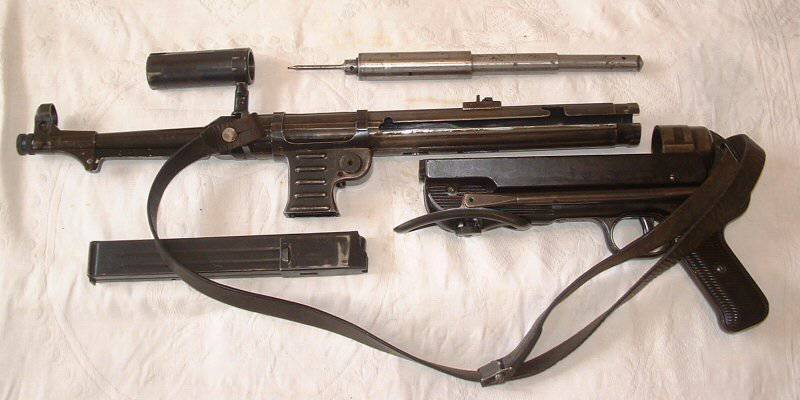
On this cover just need to stop. This is exactly the pattern of solving a technical problem that makes the weapon famous and brings fame to the designer. The problem of the pistol-machine guns existing at that time was in an excessively high rate of fire, which is characteristic of a weapon with automatic shutter. To reduce the pace, an obvious solution was used - an increase in the mass of the shutter (700 grams in MP-18) and an increase in the stroke length of the moving parts. Volmer's telescopic cover reliably protected the return spring from dirt and, moreover, worked as a buffer to reduce the rate of fire to 350-400 rds / min. The famous MP-40 chomping sound is just the work of the Folmer's “telescope”.
What was the need to reduce the rate of fire? First, the reduction in mass of the shutter. Secondly, the barrel began to heat up less when firing. The mass of metal from the barrel housing, moved to the trunk. The weapon became more stable when firing, because after the shot it had time to return to the line of aiming. In addition, it became possible to conduct a single fire without any switch. Here is a great example of this solution, when changing one detail affects the change in the design as a whole! This is really a patent. To circumvent such a decision is almost impossible. Any other solution will either be more difficult or more expensive. As an example, Finnish Suomi. Rather, the decision itself to slow down the shutter due to the effect of vacuum braking.
The customer of the MP-40 was armored control. But the remarkable characteristics of this weapon enthralled the entire army leadership and the MP-40 began to enter other branches of the army.
Hugo Schmeisser could not resist the temptation to squeeze the maximum out of the pistol cartridge and his MP-28. He lengthens the barrel, brings the store neck down, and most importantly, Volmer’s modest and elegant “reciprocation” returns spring in the telescopic housing. The product is called MK-36.

Further, an experimental batch of several pieces of these carbines did not matter. But! Schmeisser would not be Schmeisser if the inscription “SYSTEM SCHMEISSER PATENT” did not appear on the receiver. Actually the patent, apparently, concerned the translator of fire. And not a word about Volmer!
Part Eight MP-40 becomes Schmeisser
In 1940, ERMA (the patent holder for the MP-40) did not cope with the production volume and part of the order for the MP-40 was made by Herr Hänel (the Schmeisser brothers). In gratitude for this, Schmeisser creates the MP-41. In this device, the same MP-40 was easily recognized, but without a rifle hook and instead of a folding butt it was attached a massive wooden one. But, most importantly, on the receiver in large letters adorned the same inscription:
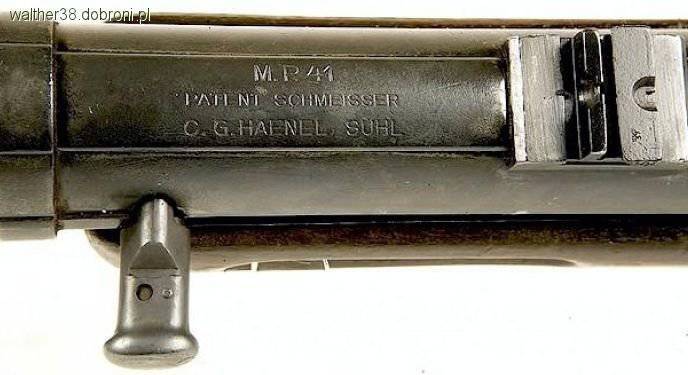
and on the store too:
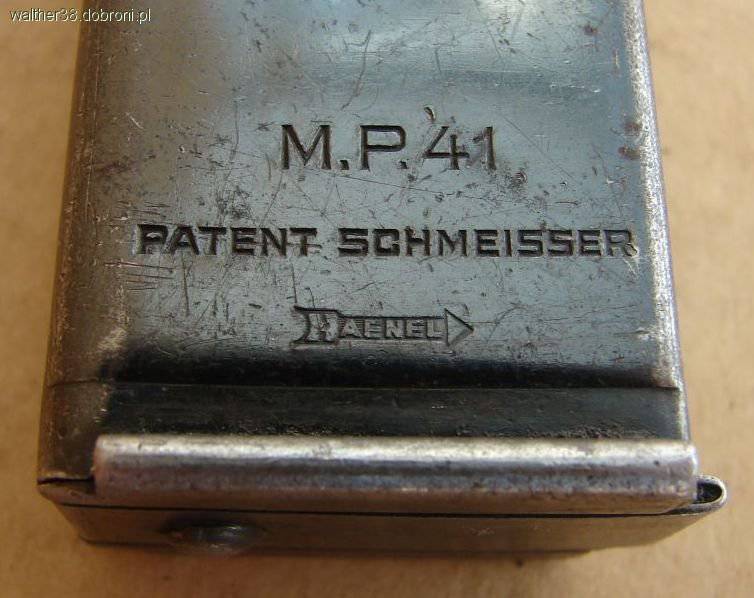
This innocent joke was the subject of litigation between ERMA and HAENEL. In fact, the fact that the Schmeisser patent in MP-41 only costs the fire mode switch, it is God with him. Just for the sake of courtesy, at least it was worth mentioning Volmer. Schmeisser lost the case in court, but he got permission for the springs. No wonder - in his bathhouse Hermann Goering himself steamed. The weapon was released in small editions and was distributed between the guards from the SS, the Balkan partisans and the fine connoisseurs of the weaponry exotics - Romanians. But the cause for which all this was started was done. Neither Vollmer nor Heipel, somehow not particularly puzzled by the problem of the immortality of their names, besides on military products it was forbidden to use any marking, including patent, except for the brand of weapons, the serial number and the conditional code of the manufacturer’s plant.
But the name of Schmeisser was already well-known due to the mention of MP-18 and MP-28 on the receiver boxes, pocket pistols, Parabellum stores and airguns produced by HAENEL. This weapon did not differ in any special quality and was not distinguished from the others, except for the mention of a patent, the essence of which the absolute majority did not know and did not want to know. The start of the release of the MP-41 coincided with the start of the mass release of the MP-40, moreover, at the Hänel company, apparently due to a reduction in the release of the MP-40. Remained a little. At one enterprise, two externally similar products are produced, one of which is completely impersonal, on the other, in the most visible place there is a mention of the Schmeisser patent. What happened was to happen. The long name “mashienpistole” or “kugelspitz” was replaced by a short and savory “Schmeisser.”
Part Eight How one "ingenious" designer got into a stupid situation, and what it cost German soldiers on the eastern front
Everyone who is more or less interested in the “weakness” of the supply spring in the MP-40 stores is probably known history German weapons. In fact, the story is much more interesting. In this store, the method of rearrangement of the two-row supply of cartridges to the supply window in one row was applied. According to the completely correct design of the designer, such a restructuring reduces the length of the extension of the cartridge on the way from the store to the chamber. With a double-row pitch, an additional distance from the magazine to the chamber is required in order to transfer the cartridge to the feed axis. In the conditions of the German Ordnung and exemplary military companies in Europe, no complaints about the work of the store and weapons did not arise. The rear provided the troops with winter and summer gun grease. After the fights, the soldiers wrote letters to their wife and children at home, and, sitting in comfortable tents and dugouts, carefully cleaned and greased their “machinists” and “machinewhevers” and cartridges to them.
In the conditions of barbarous Russia you become a barbarian. The defeat of the Germans near Moscow was aggravated by the refusal of the weapon due to the fact that during the winter lubrication was not delivered, it was necessary to warm the weapon at night with heated bricks. In the summer, “machine-painting” shops began to give tricks. It looked like this. The first shot was fired, and on the second, it flew over the cartridge and rested against the breech cut. The next patron did not rise from the store and did not get up on the dismounting line.
German soldiers began to massively throw their "Schmeissers" and hunt for Soviet PCA (this is humor, a paraphrase about how American soldiers massively threw their M16). The situation has reached such a level that the research was entrusted to Dr. Eng. Karl Meier from the MAUSER team. His scientific findings were disappointing. Wedge cartridges in the store due to the design of the store. On the segment of rebuilding of two rows of cartridges into one, a wedge occurs due to the increasing friction force in case of dust entering the magazine. Accurate lubrication of cartridges, oddly enough, only helped the occurrence of the defect.
The solution to this problem - the complete destruction of dirt and dust in a single country was not possible. A doctor-engineer Mayer had only to state: "Unfortunately, the designer, having entered changes into the store's device (just rebuilding the cartridges on the central filling line), got into a stupid situation, which, in addition, manifested itself too late." If the engineer-engineer knew what such a designer got into a stupid situation:
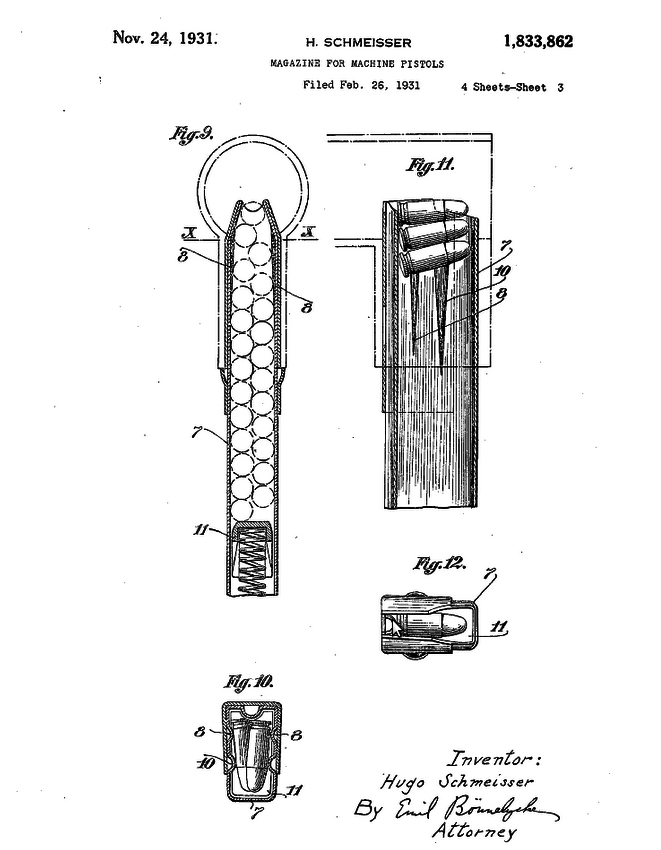
Remark 3. Under the modest charm of the German genius, unfortunately, George Semenovich Shpagin also fell. In the box shop PPSH-41, the reloading of cartridges to the centerline was also applied. But the designer from God, Aleksey Ivanovich Sudaev, corrected this mistake and supplied the best submachine gun of the Second World War with an ordinary two-row shop.
Remark 4. During the war years, about 12 of millions of stores were sold under the Schmeisser patent. If from a pfennig store, how much is it at the current rate?
You can smoke and recover.
To be continued
Information